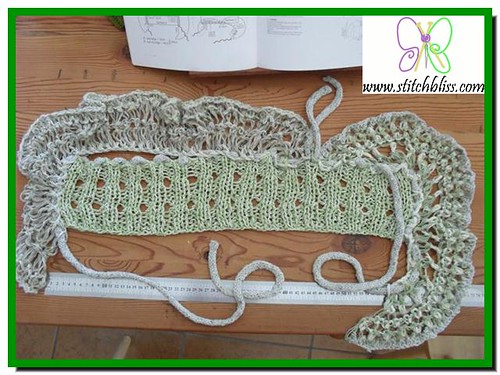My daughter really fancied the Ra-Ra Cape from Knit Issue 7.

This pattern calls for 10 different balls of yarn in 5 separate pieces loosely joined by 3 i-cords. Reading through the pattern, I noted that several of these shades were only used for a relatively small amount of knitting. I decided to make a version of this pattern from mostly remnant yarn, to get an idea of the amounts needed.

Section 1 and 2
I used
Alpaca Silk Georgette, Kelp, 1 ball for both sections. I used
Sirdar baby bamboo, Willow to edge section 1.
Section 1 was straightforward, and a pretty lace pattern. The pattern calls for lightly ironing this piece before assembly. Instead I dampened the piece and gently stretched it to shape, pinning the section to my ironing board to dry overnight. I feel that this displays the lace pattern to advantage, without the risk of distorting the piece by ironing.
Section 2 is simple crochet. The crochet instructions in this pattern are written in USA style. I found this a bit annoying. The pattern book is published in Australia, and it is an error, in my opinion, to publish in this country, for distribution in this country, using non-Australian terms without noting this use in the pattern.
In spite of translating from USA to Australian/British crochet terms, I found that using the ASG for the crochet ruffle rather than the mohair indicated (or maybe not having a tension gauge to aspire to) left me with a crochet ruffle far less wide than the blocked knitted lace ruffle. I added a shell edging to increase the width.
RS: 1dc,*miss 1 stitch, 5tr into next stitch, miss 1 stitch, 1dc into next stitch: rep from*

Section 3
This is the only part of the garment for which a tension is given. Using the tension gauge, this piece is 60cm in length.
There is an error in this section. The first 6 rows are correct, except for the double asterisks at the end of row 6, which should be ignored.
Rows 7 - 12 Rep rows 1 to 6.
Rows 13 - 17 Rep rows 1 to 5.
Cast off in rib pattern.
I used Alpaca Silk Georgette in Kelp, and
Aslan Trends Glaciar Del Cielo, in colour Green Tea for section 3
Section 5 and 6 were constructed as written, using the same
Rare Comfort Kid mohair shade for both (Damask) (C and D), with the other yarns being
Silkroad DK Tweed in Magnolia (this is yarn E in the pattern, and I used it as yarn E), substituting
Aslan Trends Artesenal in Champagne for yarn F, and using the Green Tea cotton (I), the Baby Bamboo Willow yarn (J) and
Jo Sharp Soho Summer Cotton in Crete (H) as the three cottons.
The i- cords were made from the Baby Bamboo, in Willow, and in the Magnolia shade of the Silk Road DK tweed. The crochet flowers (translated from American again) were made in the Green Tea cotton.
I then started the assembly. This was not straightforward, as the diagrams are not to scale.

As section 3 is 60cm long, and Section 5 is attached to it for 20 cm, followed by a 25 cm gap, then attached for an unspecified length, it is important to note that Section 5 is attached at least 3/4 of the way along the length of Section 3, not 1/2 way along as Diagram 1 would indicate. (I unpicked ;( )

I found that Section 4 was slightly gathered to Section 3 to achieve the 13cm unattached edge at the left.

I found all the i-cords rather too long in this garment. In retrospect, I could have made them a third shorter with no problems for wear by an average sized woman.
I will write about the next assembly steps in a further post.
















